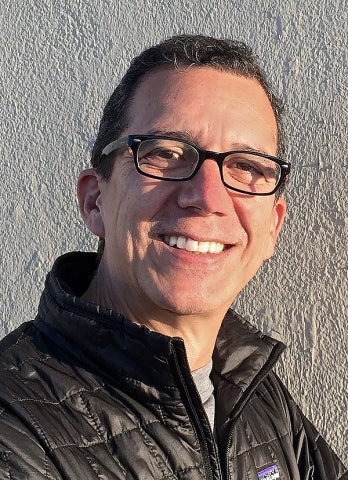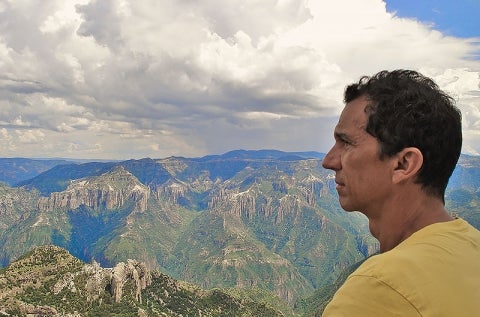Guillermo Castilleja ’83 M.F.S., ’91 Ph.D. has been described as a “true systems thinker,” something he says he developed during his time at F&ES working under F&ES Prof. Herb Bormann. Systems thinking, Castilleja says, has been key in his work both as a scientist and in his current role as senior fellow at the
Gordon and Betty Moore Foundation where he oversees strategy and serves as special advisor to the president. Previously, he was chief program officer of environmental conservation initiatives, which account for the lion’s share of the $6.5 billion private foundation.
Castilleja is also chair for the
Global Alliance for the Future of Food and on The Economics and Ecosystems of Biodiversity Advisory Board and the boards of the Climate and Land Use Alliance and the Fondo Mexicano Para La Conservación De La Naturaleza, A.C./Mexican Fund for the Conservation of Nature, A.C.
He will be honored with a Distinguished Alumni Award this coming Saturday at the F&ES Reunion Weekend. As part of the celebration, Castilleja will present a talk entitled “Conservation Paths, From Nature Sanctuaries to Commodities Markets.”
We recently caught up with him to hear more about his vision for the foundation, his advice to current students, and where he finds hope as a conservationist.
Q: First, tell me a little bit about your role at the Gordon and Betty Moore Foundation.
GUILLERMO CASTILLEJA: I have been with the Moore Foundation for seven years now. During the first six years I was chief program officer for environmental conservation, which is one of the four major programs that the foundation supports. The other three are: science, patient care, and the Bay Area. Environmental conservation is about 50 percent of the foundation. My role as chief program officer was to basically oversee the development of initiatives, to orchestrate the grant making, and to make sure that we had a good way of tracking results to be able to monitor what happened with our investments in big areas where the foundation works. After six years in that role, I was asked by the president [Harvey Fineberg] to become senior fellow and focus exclusively on strategies and to work with him directly.
Q: I’ve read about some of the initiatives that the Foundation supports, such as the Andes-Amazon Initiative. In your current role, how are you creating a vision for the foundation that supports those initiatives? And are there new initiatives or other programs that you’re developing?
CASTILLEJA: When I came six years ago, the initiatives that were in place were for the most part place-based — huge and important places of course, like the Amazon Basin or the North Pacific wild salmon ecosystems. Now even though those programs have been very successful, and have managed to protect a lot of natural habitat, the question is whether we are making a difference at the scale and speed with which change is happening in the world. It was clear that we needed to start putting more attention on global processes driving natural habitat loss. Not shifting away from the protected areas, or abandon that work, but to bring more emphasis on global phenomena like the explosion of the middle class and the resulting demand of agricultural and seafood commodities largely produced through unsustainable practices.
So we carried out an investigation with support from McKinsey that helped us identify all the key commodities that over next 30 years are going to be key in determining the fate of many of the ecosystems that we care about. We decided to focus on markets, as opposed to policy or taxes. Given the reach and control commodity markets exert globally, with the right incentives, they can enable or restrain pressures on natural habitats resulting from an increased demand of things like soy, beef, shrimp, et cetera. One of our objectives was to be able to use the market to amplify any kind of improvements and practices that have had positive impacts on the environment.
Q: How has your scientific training helped you to think about conservation on a larger, systems scale?
CASTILLEJA: Well, first of all, I think that it was precisely because of my training in the Forestry School under Herb Bormann that I really understood the importance of systems, and that nature is a holistic system that needs to be understood holistically. One of the things that he used to tell us was: “Think in terms of systems, don’t be a linear thinker.” And he was very adamant about the importance of looking at complexity as a real way in which nature organizes itself.
Years later, it was the shear notion that we are winning some battles, but losing the war which made me think of addressing problems at the scale at which they are happening. When you look at the trends globally, you see that everything is going in the wrong direction. One can very easily be somewhat comforted by the notion that protected areas have been expanding over the last 20 years, which is really magnificent. But when you compare that with what is happening — and what is likely to happen given the clear socio-economic trends and the increasing demand of an ever affluent population for a lot of stuff — it’s inescapable that you have to think about actions that need to happen at multiple levels.
Q: You’re very enmeshed in a lot of complex and daunting issues. Where are you seeing signs of hope?
CASTILLEJA: When I first started studying forest ecology, one of the most notable environmental sore spots was deforestation in the Amazon — at the time it felt like the Amazon was up in flames and basically there would be nothing left and everything was very doom and gloom. In a way, I was taking that catastrophic outcome for granted that it was going to be like that no matter what. But once I started working more in the Amazon during my days with World Wildlife Fund, I realized that there were things that could be done; that it was not all lost.
I was involved in a project in Brazil that helped put 12 percent of the Brazilian Amazon in permanent protection. The initiative included setting up a fund to generate the resources needed to run the parks over the long-term. This program, called ARPA — Amazon Protected Areas Program — was established about 15 years ago and it’s still going and creating more parks. Many of those parks were created precisely in the areas that were being deforested the fastest. And together with other policies that the government has stated, they were able to contain deforestation; deforestation went down from almost 27,000 square kilometers a year to less than four thousand.
So 80 percent deforestation reduction over five years; the Amazon is still more than 85 percent forested; and deforestation rates are the lowest in 25 or 30 years. That gave me a lot of hope that not everything is lost and that one should not just take for granted that because the issue is so big and so overwhelming and everybody talks about how dreadful it is, it cannot be addressed.
I think that part of the problem is, as those of us in environmental NGOs know very well, you have to sound the alarm bell so that you can get attention to the problem. But at some point you have to stop sounding the alarm and roll up your sleeves and carry the water because the issues can be addressed. It’s not “everything’s lost.” So to me, that type of evidence is quite important to really feel motivated to do this work. It’s not necessarily all bad.
Q: What kind of advice would you give to students as they embark on their careers?
CASTILLEJA: It would be two things: One is that you have to be good at something. You need to develop a real skill that you can rely on and that gives you some kind of specialty that you can use to start somewhere and have a specific role to play in a team. But also try to keep yourself flexible and don’t get overexcited about the first thing that you see. Keep yourself flexible while you go through your studies, particularly if you come to the Forestry School with a very strict idea of what you want to do based on what you’ve have done in the past. I think students thinking that way are missing the opportunity that Yale really provides, which is to open up to other ways of thinking, to other possibilities of research, or to other possibilities of work that may not have been what you originally had in mind. I think that Yale is a very good place for people to come in with an open mind as opposed to coming in with a narrowly focused approach of what they want to achieve at the end.
 Guillermo Castilleja
Guillermo Castilleja
 Guillermo Castilleja in Cooper Canyon, Mexico.
Guillermo Castilleja in Cooper Canyon, Mexico.